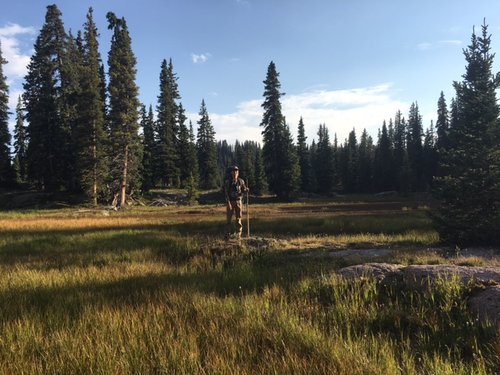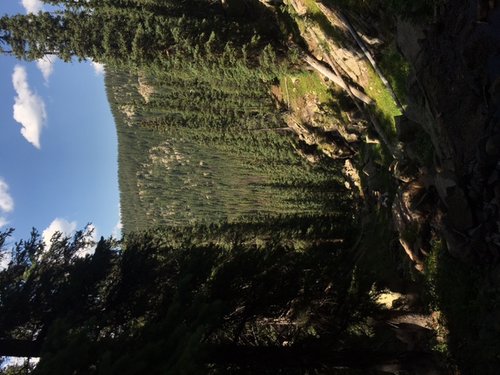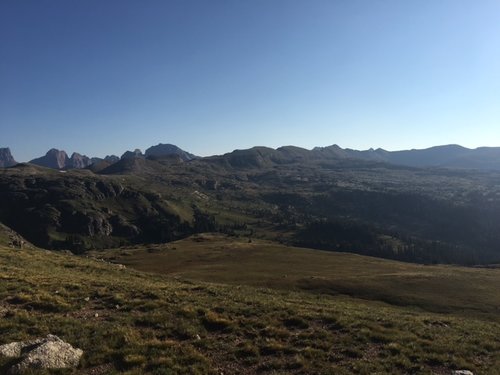nwchen24
New member
Having hunted close to my home in Denver for my first elk hunt last year only to see more other hunters than elk, I decided to get just about as far away from there as I could for my second shot this fall.
My buddy flew in from Virginia on Friday evening and we left early Saturday morning to make it to the first spot we had identified. After a long drive to Durango and another two hours on dirt roads to get to our pack in spot, we were excited to find only two other rigs and a non-hunting camper at the trailhead (whether we should have taken this as an indication of a lack of elk in the area is a question we certainly thought about later). As we packed up our gear for our foray into the back country, the hunters owning both the rigs at the trailhead came out of the woods. One had had an encounter with a bull in the timber while the other group hadn't seen anything. Both were moving on to other grounds meaning we'd have this particular chunk of ground to ourselves (again, this begs the question, should we have taken these other hunters actions to mean we should have looked for other areas?)
After hiking along some old closed logging roads, we set up our first camp. The following morning, we got up and glassed, without seeing anything, but a couple of brilliant hawks soaring over the sunrise. The entire area seemed like great elk habitat with timber, water, meadows, and steep canyons, but we were not finding much fresh elk sign - only a whole lot of black bear sign and rooting.

The next day, moving to find another spot to set up camp, we bumped a bull out in a meadow at the bottom of a draw in broad daylight. This got us excited and rejuvenated our hopefulness for hunting the area. Another day passed where we found a fresh trail leading into a canyon, but otherwise, not much in the way of fresh sign. We spent the next morning and evening sitting on the trail hoping to catch an elk in moving into or out of the canyon with no luck.
We then decided we'd committed several days to this area without much promise so we decided we would give it one last hurrah. Being somewhat impatient, we tried an unconventional tactic and tried to stalk up one of the canyons in the area where we had found trails leading down. We bumped another bull that took off crashing through the woods on the way down. We were able to follow his tracks coming back up the canyon, but eventually lost him where the canyon widened. This was the steep stream we followed down into the canyon bottom before bumping that bull.

Having struck out in these timbered canyons, we decided we would head for more conventional country and drove up, up, up to a higher elevation location with some more promising glassing locations. Again, we spent a couple of days glassing here, but found only old sign and didn't see anything but for a pack of coyotes as we crested a ridge. We did find some old velvet a bull must have shed earlier in the summer, but nothing living and breathing. The country was beautiful, but unfortunately didn't seem like it would be productive for us.

Part of the resolution we made before the trip was that we wouldn't invest too much time in any area that didn't show promise in the way of sighting animals or finding fresh sign within a couple days, so we again, moved on - driving another hour back along a dirt road and another long hike in to set up camp. This last spot was another similar lower elevation (9,500 - 10,000 feet or so) area as our first location with canyons running down from a higher ridge line. The only factor we didn't anticipate here were the exorbitant amounts of cattle. They were everywhere which at first got us pretty discouraged.
That first night at our new spot, we set out to glass some of the ridges extending from the main ridge, and lo and behold, we saw a solitary bull at about 800 yards making his way up the canyon as the sun set. We couldn't watch him for long as he disappeared into the trees only a minute or two after we spotted him. The next morning, and evening, we went over to stake out the meadow we'd seen him pass through, but he didn't come by again.
Our last morning of the hunt, driving out, we spotted three cows on an opposing hillside. In a last ditch effort, we grabbed our essentials and booked it over to the hillside, but they'd long since moved through by the time we covered the mile or so to get there. In this instance, the cow tracks may have actually helped us to move through the woods faster.
All in all, we had some trouble finding elk reliably in such a way that we could hunt them. We saw three solitary bulls who seemed to like to hang out in the lower elevation canyons, but didn't have the time, patience, or know how to devise an effective strategy to hunt them. The cows on the last day showed us that there were definitely elk in the last area we hunted, but again, given this was our day to drive back to Denver, we weren't able to be patient about hunting them. Compared to last year where we mainly saw other hunters and no elk, this was a step in the right direction. Looking forward to getting a second shot during rifle seasons this fall or the next archery hunt next year!
My buddy flew in from Virginia on Friday evening and we left early Saturday morning to make it to the first spot we had identified. After a long drive to Durango and another two hours on dirt roads to get to our pack in spot, we were excited to find only two other rigs and a non-hunting camper at the trailhead (whether we should have taken this as an indication of a lack of elk in the area is a question we certainly thought about later). As we packed up our gear for our foray into the back country, the hunters owning both the rigs at the trailhead came out of the woods. One had had an encounter with a bull in the timber while the other group hadn't seen anything. Both were moving on to other grounds meaning we'd have this particular chunk of ground to ourselves (again, this begs the question, should we have taken these other hunters actions to mean we should have looked for other areas?)
After hiking along some old closed logging roads, we set up our first camp. The following morning, we got up and glassed, without seeing anything, but a couple of brilliant hawks soaring over the sunrise. The entire area seemed like great elk habitat with timber, water, meadows, and steep canyons, but we were not finding much fresh elk sign - only a whole lot of black bear sign and rooting.

The next day, moving to find another spot to set up camp, we bumped a bull out in a meadow at the bottom of a draw in broad daylight. This got us excited and rejuvenated our hopefulness for hunting the area. Another day passed where we found a fresh trail leading into a canyon, but otherwise, not much in the way of fresh sign. We spent the next morning and evening sitting on the trail hoping to catch an elk in moving into or out of the canyon with no luck.
We then decided we'd committed several days to this area without much promise so we decided we would give it one last hurrah. Being somewhat impatient, we tried an unconventional tactic and tried to stalk up one of the canyons in the area where we had found trails leading down. We bumped another bull that took off crashing through the woods on the way down. We were able to follow his tracks coming back up the canyon, but eventually lost him where the canyon widened. This was the steep stream we followed down into the canyon bottom before bumping that bull.

Having struck out in these timbered canyons, we decided we would head for more conventional country and drove up, up, up to a higher elevation location with some more promising glassing locations. Again, we spent a couple of days glassing here, but found only old sign and didn't see anything but for a pack of coyotes as we crested a ridge. We did find some old velvet a bull must have shed earlier in the summer, but nothing living and breathing. The country was beautiful, but unfortunately didn't seem like it would be productive for us.

Part of the resolution we made before the trip was that we wouldn't invest too much time in any area that didn't show promise in the way of sighting animals or finding fresh sign within a couple days, so we again, moved on - driving another hour back along a dirt road and another long hike in to set up camp. This last spot was another similar lower elevation (9,500 - 10,000 feet or so) area as our first location with canyons running down from a higher ridge line. The only factor we didn't anticipate here were the exorbitant amounts of cattle. They were everywhere which at first got us pretty discouraged.
That first night at our new spot, we set out to glass some of the ridges extending from the main ridge, and lo and behold, we saw a solitary bull at about 800 yards making his way up the canyon as the sun set. We couldn't watch him for long as he disappeared into the trees only a minute or two after we spotted him. The next morning, and evening, we went over to stake out the meadow we'd seen him pass through, but he didn't come by again.
Our last morning of the hunt, driving out, we spotted three cows on an opposing hillside. In a last ditch effort, we grabbed our essentials and booked it over to the hillside, but they'd long since moved through by the time we covered the mile or so to get there. In this instance, the cow tracks may have actually helped us to move through the woods faster.
All in all, we had some trouble finding elk reliably in such a way that we could hunt them. We saw three solitary bulls who seemed to like to hang out in the lower elevation canyons, but didn't have the time, patience, or know how to devise an effective strategy to hunt them. The cows on the last day showed us that there were definitely elk in the last area we hunted, but again, given this was our day to drive back to Denver, we weren't able to be patient about hunting them. Compared to last year where we mainly saw other hunters and no elk, this was a step in the right direction. Looking forward to getting a second shot during rifle seasons this fall or the next archery hunt next year!




